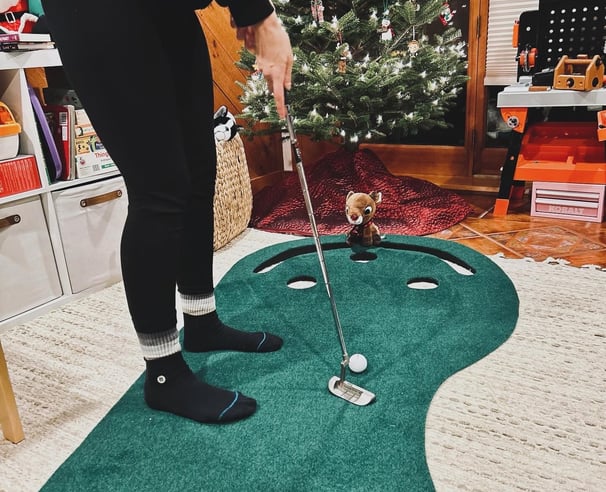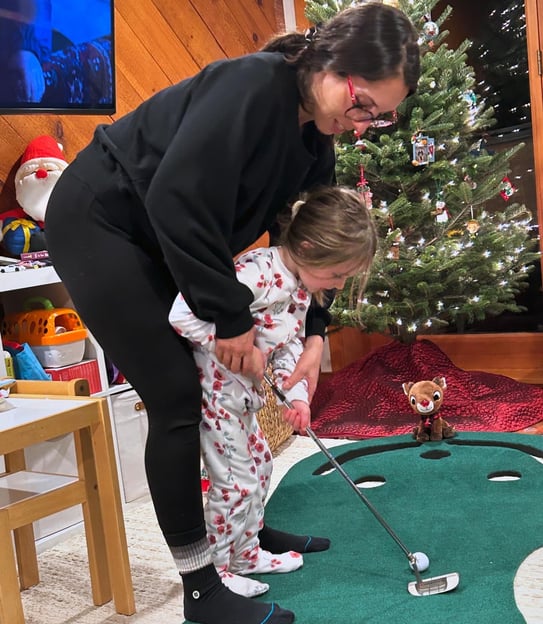Practicing Golf at Home: A Busy Mom’s Guide to Improving Your Game While the Kids Play
Blog post description.
12/12/20246 min read


As a busy mom, my time is always at a premium. Between school runs, grocery shopping, and trying to maintain some semblance of a social life, finding time to practice golf can feel like a luxury. But here's the thing: I’ve realized that with a little creativity, you don’t need to hit the course every day to improve your game. With a few simple tools and some clever strategies, you can practice golf right at home while the kids are playing, napping, or even having their own quiet time.
I’m learning that golf is about more than just hitting a ball—it’s about improving technique, building muscle memory, and getting a feel for the swing. The beauty of practicing at home is that I can fit in short sessions whenever I can sneak a few minutes. So, if you're a busy mom like me and you want to practice golf without leaving the house, here are a few ways to keep improving your game—without sacrificing your mom duties.
1. Indoor Putting Practice: Mastering the Short Game
One of the easiest ways to practice at home is by focusing on your putting game. Putting doesn’t require a lot of space, and it’s a great way to work on accuracy and finesse. Here are a few ways I practice my putts at home while keeping an eye on the kids:
Create a Mini Putting Green: All you need is a flat surface—your hallway, living room, or even the kitchen floor. Grab a small practice putting mat, which you can find online or at most sporting goods stores, or make your own with a piece of carpet. The great thing about putting is that you can do it anywhere there’s enough space.
Use Household Items as Targets: If you don’t have a putting cup or hole, get creative. Use a small bowl, a coffee mug, a rolled-up towel to simulate a hole or Rudolph! Set it at varying distances and practice lining up your shots.
Focus on Your Stance and Alignment: While putting, I focus on my stance, hand position, and alignment. It’s easy to get distracted, but even five minutes of quality putting practice can help build muscle memory. Plus, it’s super low impact—perfect for a quick break while the kids play nearby.
2. Chipping Practice with Soft Balls (or Towels)
Chipping is another important part of your golf game that you can work on indoors or in your backyard (if you have the space). It’s all about precision and getting the right feel for your short game.
Use Soft Foam Balls: I love using soft, foam golf balls when practicing in the house or outside. They’re safe for indoor practice (no need to worry about breaking anything) and allow you to focus on the mechanics of your swing. I’ll chip them toward a target like a bucket, laundry basket, or even a laundry pile (don’t judge, it’s a multi-tasking moment).
Chipping Towels: If you don’t want to deal with foam balls, you can use rolled-up towels as makeshift targets. I’ll set up a towel in my living room or backyard, and practice hitting small, controlled chips toward the target. It’s great for building your short game and it doesn’t take up a lot of room.
Focus on Swing Form: As I chip, I focus on the technique—keeping my wrists firm, following through, and keeping my head still. Practicing a smooth, controlled motion is just as important as practicing the actual contact with the ball.
3. Swinging Practice with a Weighted Club or Resistance Bands
A big part of golf is building strength and flexibility. I’ve found that I don’t need to be at the driving range to work on my swing. Here’s how I practice at home to improve my swing mechanics and strength:
Swinging with a Weighted Club: If you don’t have access to a golf club with weight, you can use a lightweight club (or even a broomstick) and simply swing it slowly. The key is to work on form, which will translate to a better full-speed swing on the course. If you’re serious about it, you can also purchase a weighted golf club or training aid.
Resistance Bands: Resistance bands are my secret weapon for building strength and flexibility, and they’re perfect for quick practice at home. I use the bands to mimic the golf swing, which helps me build up the muscles I need for a strong, controlled shot. It’s also great for improving rotation and flexibility in my torso and hips.
Slow Motion Practice: If I’m trying to work on a specific part of my swing, I’ll go slow and break it down step by step. I’ll practice the motion slowly—focusing on the takeaway, the backswing, the downswing, and the follow-through. It’s like rehearsing the perfect dance move, but with a golf club.
4. Mirror Practice for Swing Technique
Sometimes, the best way to improve your swing is by seeing it. I’m fortunate enough to have a full-length mirror in my bedroom, so I use it to check my posture and form.
Practice Your Swing in Front of a Mirror: I stand in front of the mirror and go through my full swing motion—slowly. The mirror helps me catch things like hunched shoulders or improper arm positioning, which I might not notice otherwise. It’s like having a built-in coach, reminding me to keep my elbows in, rotate my hips properly, and maintain good posture.
Check Your Follow-Through: Another area I focus on is the follow-through. I watch to make sure I’m finishing my swing high and following through, rather than cutting it short. This has helped me improve both the distance and accuracy of my shots.
5. Mental Game: Visualization and Relaxation
Golf is as much about your mental game as it is about your physical one. One of the best things about practicing at home is that I can work on my focus and relaxation skills without the pressure of being on the course.
Visualization Techniques: While the kids are playing or napping, I take a few moments to close my eyes and visualize myself hitting a great shot. I imagine the feeling of making solid contact with the ball, seeing the ball fly through the air, and landing in the perfect spot on the green. It’s a great mental exercise that helps improve my confidence.
Breathing and Relaxation: Golf can be stressful, especially when you're learning, but I’ve found that taking deep breaths and staying relaxed makes a huge difference. I’ll practice a few minutes of deep breathing or even do a quick meditation session to clear my mind before heading out to play.
6. Incorporating the Kids: Family-Friendly Golf Fun
As any busy mom knows, there’s never enough time for “me” moments, but I’ve found ways to make golf fun for the whole family. When the kids are playing or hanging around, I’ll get them involved in a low-key way:
Mini Golf Challenges: I’ll set up a mini putting or chipping challenge in the backyard or living room and let the kids join in. It’s a great way to spend quality time together and let them learn the game in a relaxed, fun setting.
Golf-Themed Games: If the kids are running around outside, I might challenge them to “hit” a ball with a plastic club or try to chip a ball into a target (like a bucket or a cardboard box). It keeps them engaged while I work on my own shots.
Final Thoughts: Practice Doesn’t Have to Be Perfect (or Complicated)
Being a mom means multitasking, and golf practice doesn’t have to be any different. Whether it’s swinging a club in the living room or working on putting while the kids are playing, there are plenty of ways to improve your game without leaving the house. The key is consistency—even if you only have 10 or 15 minutes here and there, those little moments add up.
So, if you’re a mom looking to improve your golf skills, don’t stress about finding hours to practice. With a little creativity, you can squeeze in practice whenever you can—while keeping an eye on the kids and staying on top of life’s other demands. Grab your clubs (or a broomstick), find a little space, and get swinging!



Follow Along
© 2024. All rights reserved.
Menu
TEE TIME WITH MOM
